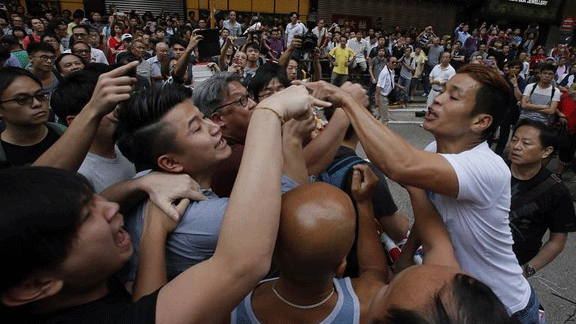Hong Kong erupts

Sid Zoichi is currently on the ground in Hong Kong reporting for Red Flag. Follow @RedFlag_news on Twitter for updates and redflag.org.au for interviews and reports.
An inspiring protest movement has swept Hong Kong. Normally, you only find news of this city in the travel and stock market sections of the newspapers. But suddenly pictures of Hong Kong students equipped with umbrellas and goggles and facing down police and thugs are hitting front pages.
The movement has been brewing for some time. The annual number of protests and demonstrations reached more than 7,000 in recent years – an average of 20 protests every day.
Beneath the image of prosperity and affluence, tremendous inequality exists. The island’s Gini coefficient, the standard measure of inequality, is one of the highest among developed countries. Its skyrocketing property prices and flourishing financial sector generate a tremendous number of millionaires and billionaires, but its minimum wage is a miserable HKD$28 (about A$4) per hour. And the cost of living in Hong Kong is not necessarily lower than in Australia.
An undemocratic election process, which privileges the representatives of Hong Kong’s capitalist class and denies genuine universal suffrage, is widely hated. It was first established by the British during the colonial era, but, since China resumed control in 1997, it has maintained the status quo. An autonomous government in Hong Kong that granted concessions to the labour movement would definitely fan the flames of industrial unrest in China’s Pearl River delta, or even further to the north.
This is why the Chinese central government has been constantly manoeuvring around the promises and laws made prior to 1997, which said clearly that Beijing would not interfere in Hong Kong’s internal politics during the first 50 years of reunification.
There are about 3.5 million voters in Hong Kong. However, the top leader, the chief executive, is nominated and elected by an election committee of 1,200 members, the majority of whom are loyal followers of Beijing. Only about 240,000 voters have the right to vote for those committee members. Furthermore, the elected chief executive must be approved by the National People’s Congress (the rubber stamp of the Communist Party) before taking office.
This set-up has been criticised and opposed by pro-democracy groups, which are known as the Pan-democracy Camp. In response to majority sentiment, the central government instructed current chief executive Leung Chun Ying to formulate a seemingly progressive solution, which would allow all Hong Kong permanent residents to vote for the chief executive directly after 2017.
However, the government stipulated that candidates still must be preselected by the 1,200-person election committee.
This deception was the trigger for student strikes and sit-in protests led by the Hong Kong Federation of Students. Students from 24 universities and colleges hit the streets on 22 September. High school students led by Scholarism, a student activist group formed in 2011, joined the struggle a couple of days later.
A large number of those students have participated in the protests against Moral and National Education, which is a school curriculum proposed by the Education Bureau of Hong Kong in order to promote patriotism among the younger generation. Together with 30 other organisations, Scholarism organised a 90,000-strong demonstration in 2012, which forced the government to drop the curriculum.
The victory gave the students more confidence, and they became more ambitious. Most of them are not satisfied with the conservative strategies pursued by the Pan-democracy Camp and are willing to take more radical action.
The student protest was hit with pepper spray and mass arrests on 26 and 27 September. However, authorities underestimated the determinations of the protesters – 60,000 were mobilised and gathered in front of government headquarters later on the night of 27 September. Subsequently, a new round of “Occupy Central”, which originally formed as part of the global Occupy movement in 2011, began the following morning.
The government realised that heavy-handed repression would only enrage more people, so the police force was ordered to step back after it fired tear gas during the first night of the occupation.
Initially, the rulers in Beijing hoped the protesters would tire quickly and disperse. It did nothing of note except to strengthen mainland censorship during the first days.
However, along with the decline of protester numbers, signs of a crackdown have started to emerge. The Chinese government’s propaganda machines are turning to a more threatening tone; more anti-riot equipment has been issued to the standby police force; and occupation camps are being attacked by unidentified thugs.
The movement in Hong Kong is at a crucial juncture.